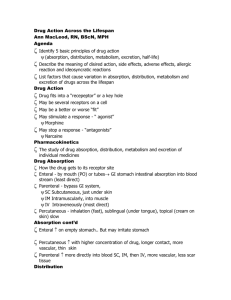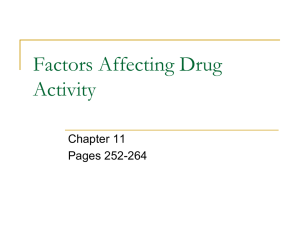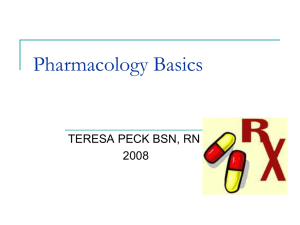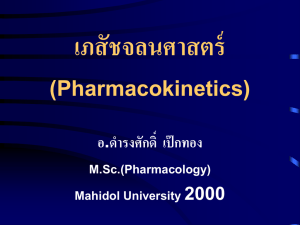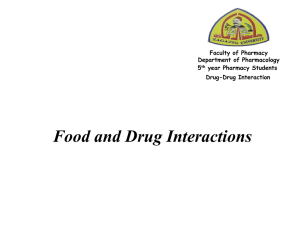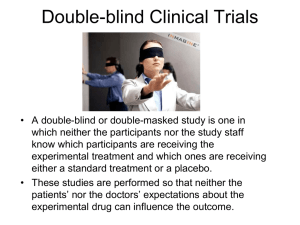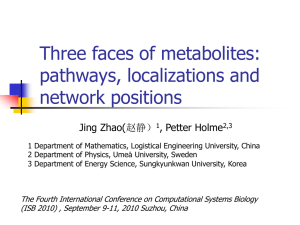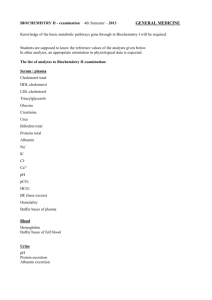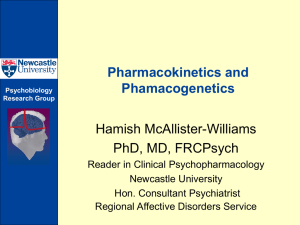Advanced Medicinal Chemistry
advertisement
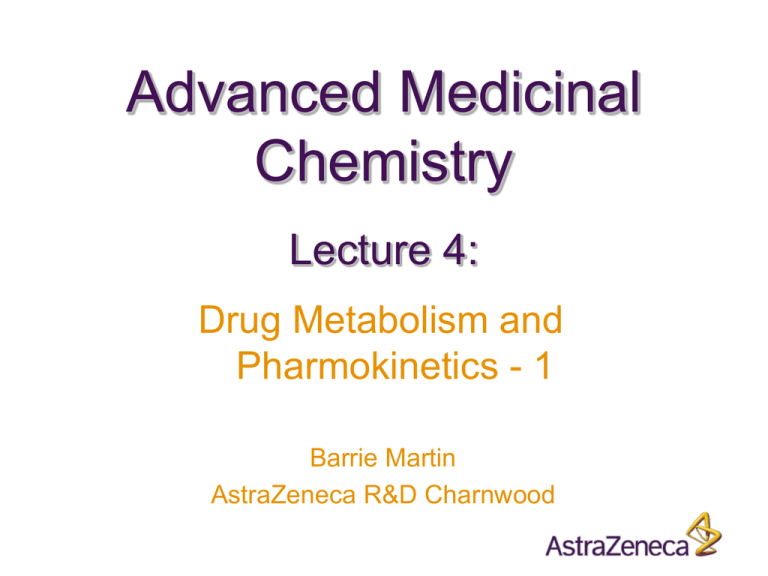
Advanced Medicinal Chemistry Lecture 4: Drug Metabolism and Pharmokinetics - 1 Barrie Martin AstraZeneca R&D Charnwood DMPK – What is it and Why study it? Drug Metabolism The chemical alteration of a drug by a biological system with the principal purpose of eliminating it from the system. Pharmacokinetics The study of the movement of drugs within the body (What the body does to the drug). Pharmacodynamics The study of the pharmacological response to a drug (What the drug does to the body). Why? Compare drug candidates –need to understand how they behave in the body in order to have confidence that they will be safe and efficaceous. Understand how to improve the in vivo properties of candidates during the Lead Optimisation process. Typical Plasma Concentration/Time Profiles Plasma conc Plasma conc Toxic Toxic MTC MTC Therapeutic Therapeutic Cssmax Cssmin Duration MEC Ineffective MEC Ineffective Time Time Understanding the DMPK of compounds allows effective prediction of appropriate doses to give safe, therapeutic concentrations MTC - Maximum tolerated concentration MEC - Minimum effective concentration Css - Steady state concentration DMPK Processes & Terminology Absorption Distribution Metabolism Excretion (ADME) For a drug which is administered orally, a number of factors affect delivery to the site of action: Absorption: the process by which a drug moves from its site of administration to the systemic circulation Distribution: the reversible transfer of a drug to and from the systemic circulation Metabolism: any chemical alteration of a drug by the living system to enhance water solubility and hence excretion Excretion (Elimination): the irreversible transfer of a drug from the systemic circulation Absorption Distribution BLOOD Elimination TISSUES Absorption Factors affecting absorption: Solubility Acid stability Permeability MOUTH Metabolism – gut wall / first pass metabolism Portal vein pH ~1 Relative SA ~1 pH ~ 7 Relative SA ~ 600 STOMACH Liver INTESTINE Metabolism Gut wall BLOOD Intestinal Wall Structure Epithelium Central capillary network Microvilli Apical surface Brush Border Membrane Epithelial Cell (enterocyte) Basolateral surface Intestinal wall epithelial cells have many finger-like projections on their luminal surface called microvilli which form the brush border membrane Absorption Mechanisms Transcellular absorption – – – – – – Main route for most oral drugs Drug must be in solution at cell surface pKa important - drug must be unionised Lipophilicity important - ideal log D 1-4 H-bonds - solvation shell needs dispersing Lipinski’s ‘Rule of 5’ Paracellular absorption – – – Drug passes through gaps between cells Inefficient – pores have << surface area than cellular surface Restricted to low MW hydrophilic molecules H 3N + O - O O O O P O O O O O Active Transport – – – Drugs carried through membrane by a transporter – requires energy Many transporters exist for nutrient molecules, eg glucose, amino acids SAR specific – few drugs absorbed by this route Phosphatidylserine Efflux Transporters - P-glycoprotein A number of efflux transporters act as a barrier to prevent entry of toxic compounds into the body P-gp (P-glycoprotein) is the most well characterised transporter ATP dependent efflux pump with broad substrate specificity. 170 kDa protein, dimeric structure connected by a linker peptide. Each half contains 6 transmembrane domains and an ATP binding site. P-gp found in high levels at apical surface of enterocytes. CYP3A4 (metabolising enzyme) also expressed - can reduce absorption through efflux/metabolism. Co-administration of compounds which inhibit P-gp can lead to increased bioavailability of drugs O OH O O ATP N O O N O OH O N N O N Cl O O Cl O OH Verapamil Ca channel blocker P-gp substrate O O O O N O N OH HO Erythromycin Macrolide antibiotic P-gp substrate/inhibitor Ketoconazole Antifungal P-gp Inhibitor Distribution Distribution: the reversible transfer of a drug to and from the systemic circulation Absorption Distribution BLOOD TISSUES Compounds can distribute out of plasma into tissues: Main factors influencing distribution are pKa, lipophilicity, plasma protein binding (only unbound tissue is free to distribute). Tissue pH is slightly lower than plasma pH Basic compounds tend to distribute out of plasma into tissue more than acids. Plasma Protein Binding (PPB) Rapid Drug Free Drug Protein Equilibrium Bound Drugs can bind to macromolecules in the blood – known as plasma protein binding (PPB) Only unbound compound is available for distribution into tissues Acids bind to basic binding sites on albumin, bases bind to alpha-1 acid glycoprotein 0-50% bound = negligible 50-90% 90-99% >99% = moderate = high = very high For bases and neutrals, PPB is proportional to logD. Acidic drugs tend to have higher PPB than neutral/basic drugs. Metabolism Definition: Any chemical alteration of a drug by the living system Purpose: To enhance water solubility and hence excretability Types of metabolism – Phase I: production of a new chemical group on the molecule – Phase II: addition of an endogenous ligand to the molecule Sites of metabolism – Main site of metabolism is the liver. – Other sites include the gastrointestinal wall (CYP-450), kidneys, blood etc. Factors affecting metabolism – The structure of a drug influences its physicochemical properties. (blocking/altering sites of metabolism can improve DMPK properties) – MW, LogP/LogD, pKa – The more complex the structure, the more the potential sites for metabolism. Phase I Metabolism N H O OH OH (i) Oxidation Aliphatic or aromatic hydroxylation N H O OH Propranolol (-blocker) N-, or S-oxidation OH N-, O-, S-dealkylation N NH N NH 2 NH NH 2 Debrisoquine (anti-hypertensive) (ii) Reduction Carbonyl reduction to alcohol (iii) Hydrolysis O H N Nitro reduction to hydroxylamine/ amine N O2N H 2N Nitrazepam (hypnotic) Ester or amide to acid and alcohol or amine Hydrazides to acid and substituted hydrazine CO2H CO2H O OH O Aspirin (Analgesic) O H N N Phase II Metabolism CHCl2 O (i) Glucuronidation HN Carboxylic acid, alcohol, phenol, amine Carboxylic acids HN OH OH O2N (ii) Amino acids O CHCl2 O HO OH O HO O2N Chloramphenicol (antibiotic) (iii) Acetylation Amines O OH N H O OH (iv) Sulfation Alcohol, phenol, amine OH Prenalterol (-blocker) (v) Glutathione conjugation (gly-cys-glu) Halo-cpds, epoxides, arene oxides, quinone-imine O O S HO O N H CO2H OH Cytochrome P450 Enzymes (CYP-450) 2e-, 2H+ RH + O2 ROH + H2O CYP-450 Many Phase I oxidations are mediated by cytochrome P450 enzymes. Membrane bound proteins - found on the endoplasmic reticulum. Heme-containing proteins – porphyrin ring co-ordinating iron at the active site. Many iso-forms with different substrate specificities: Major human CYP’s: 1A2, 2C9, 2C19, 2D6, 3A4 CYP inhibition/induction: issues in exposure + drug-drug interactions. N Fe N N N HO2C S Cys N ON Fe N CO2 H Iron(III) porphyrin HO2C . N S + Cys CO2 H Active oxygen Fe (IV) species Excretion (Elimination) Absorption Distribution BLOOD TISSUES Elimination Elimination: the irreversible transfer of a drug from the systemic circulation Major routes of elimination: Metabolism Renal excretion (for free drug, ie low logD) Biliary excretion Also lungs, sweat etc. Renal Excretion Nephron Blood Urine 1. All unbound drug in plasma is filtered in the glomerulus. Only significant for very polar compounds, log D < 0. 2. Some compounds are actively secreted into urine along the proximal tubule. 3. Unionised drug can undergo passive reabsorption from urine into blood along the length of the nephron (net excretion may be zero). 4. Drug that is bound to plasma proteins is not filtered. Biliary Excretion In the liver drugs can be secreted into the bile Liver Gall bladder Transporters in the basolateral and canalicular membranes of hepatocytes mediate uptake into the hepatocyte and efflux into bile Biliary clearance is commonly higher in Rats/Mice than in Dog/Man EHC Bile collects in gall bladder, then released into intestine upon food intake. Drug may then be reabsorbed - known as enterohepatic recirculation (EHC). Intestine Hepatic portal vein
